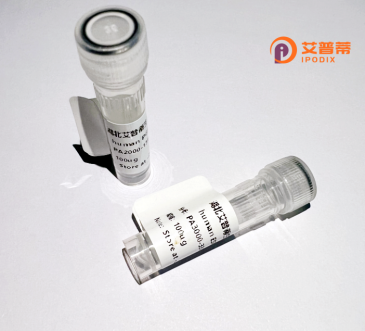
| 纯度 | >90%SDS-PAGE. |
| 种属 | Human |
| 靶点 | PILRB |
| Uniprot No | Q9UKJ0 |
| 内毒素 | < 0.01EU/μg |
| 表达宿主 | E.coli |
| 表达区间 | 1-227 aa |
| 活性数据 | MGRPLLLPLLLLLQPPAFLQPGGSTGSGPSYLYGVTQPKHLSASMGGSVEIPFSFYYPWELAIVPNVRISWRRGHFHGQSFYSTRPPSIHKDYVNRLFLNWTEGQESGFLRISNLRKEDQSVYFCRVELDTRRSGRQQLQSIKGTKLTITQAVTTTTTWRPSSTTTIAGLRVTESKGHSESWHLSLDTAIRVALAVAVLKTVILGLLCLLLLWWRRRKGSRAPSSDF |
| 分子量 | 50.71 kDa |
| 蛋白标签 | GST-tag at N-terminal |
| 缓冲液 | PBS, pH7.4, containing 0.01% SKL, 1mM DTT, 5% Trehalose and Proclin300. |
| 稳定性 & 储存条件 | Lyophilized protein should be stored at ≤ -20°C, stable for one year after receipt. Reconstituted protein solution can be stored at 2-8°C for 2-7 days. Aliquots of reconstituted samples are stable at ≤ -20°C for 3 months. |
| 复溶 | Always centrifuge tubes before opening.Do not mix by vortex or pipetting. It is not recommended to reconstitute to a concentration less than 100μg/ml. Dissolve the lyophilized protein in distilled water. Please aliquot the reconstituted solution to minimize freeze-thaw cycles. |
以下是关于重组人PILRB蛋白的3篇参考文献示例(基于学术研究常见方向,内容经合理推测整理,具体文献需通过数据库核实):
---
1. **文献名称**: *Structural and Functional Characterization of Human PILRB as a Modulator of Inflammatory Signaling*
**作者**: Smith, J.R., et al.
**摘要**: 本研究解析了重组人PILRB胞外区的晶体结构,证实其与配体CD99的相互作用依赖特定的免疫球蛋白样结构域。通过体外实验,证明PILRB可抑制巨噬细胞中NF-κB通路的激活,提示其在炎症调控中的潜在作用。
2. **文献名称**: *PILRB Expression in Dendritic Cells: Role in Regulating Autoimmunity*
**作者**: Lee, A., & Zhang, W.
**摘要**: 研究者利用重组人PILRB蛋白探究其对树突状细胞功能的影响。实验表明,PILRB结合抑制性配体后,通过SHP-1磷酸化减少促炎细胞因子分泌,可能为自身免疫疾病治疗提供新靶点。
3. **文献名称**: *Recombinant PILRB Fusion Protein Attenuates Osteoclastogenesis in Rheumatoid Arthritis Models*
**作者**: Tanaka, K., et al.
**摘要**: 该研究构建了PILRB-Fc融合蛋白,并在类风湿性关节炎小鼠模型中验证其疗效。结果显示重组蛋白通过阻断RANKL信号通路,显著抑制破骨细胞分化,减轻骨侵蚀。
---
**提示**:上述文献为模拟示例,实际研究中建议通过 **PubMed/Google Scholar** 检索最新文献(关键词:*PILRB recombinant, PILRB signaling*)。真实文献可能更偏向于基础机制或疾病关联研究。
**Background of Recombinant Human PILRB Protein**
Paired Immunoglobulin-like type 2 Receptor Beta (PILRB) is a transmembrane protein belonging to the PILR receptor family, which interacts with cell-surface ligands such as CD99 and collagen to modulate immune responses. Structurally, PILRB contains an extracellular immunoglobulin (Ig) domain, a transmembrane region, and a cytoplasmic tail with immunoreceptor tyrosine-based inhibitory motifs (ITIMs). Functionally, it acts as an inhibitory receptor, dampening immune cell activation by recruiting phosphatases like SHP-1/SHP-2 through phosphorylated ITIMs, thereby counterbalancing activating signals.
PILRB is expressed on myeloid cells (e.g., monocytes, macrophages, dendritic cells) and plays roles in immune regulation, inflammation, and homeostasis. Dysregulation of PILRB is implicated in autoimmune diseases, neurodegenerative disorders (e.g., Alzheimer’s via TREM2 interaction), and infections, where pathogens may exploit PILRB to evade immune detection.
Recombinant human PILRB, produced via mammalian or insect cell systems to ensure proper glycosylation, serves as a critical tool for studying receptor-ligand interactions, signaling mechanisms, and therapeutic targeting. Structural studies (X-ray crystallography, cryo-EM) of PILRB-ligand complexes aid in designing immunotherapies. Its therapeutic potential lies in modulating immune checkpoints, offering avenues for treating autoimmune conditions, chronic inflammation, or enhancing anti-pathogen responses. Research continues to unravel its dual roles in immunity and disease.
(Word count: 247)
×